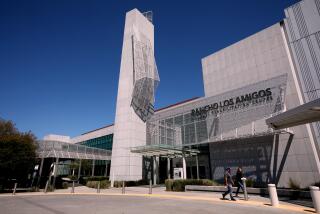Operating on Hope : Medical Teams Fly Help to Mexican Villagers Through Santa Ana Group That Operates Clinics
- Share via
SAN BLAS, Mexico — Sweat rose on Dr. Michael Farrell’s forehead as he focused on the thin, twisted limb in his hands.
Slowly, steadily, Farrell rotated the boy’s fractured arm into place.
The 4-year-old had turned the limb backward when he broke it playing the day before. Now, with the boy under anesthetic, Farrell tried to right it. A miscalculation could cause the arm’s arteries and nerves to be severed.
Putting himself into such situations is how Farrell, a 49-year-old Laguna Hills orthopedic surgeon, chooses to spend the first weekend of every month.
He climbs behind the controls of his eight-seat Cessna Chancellor airplane at the Riverside airport on Friday, turns its nose south and flies across the border to small central Mexican villages like this one.
Flying with him is a medical team of three or four and a load of medical supplies and equipment.
“It’s a break from our daily lives,” he said, explaining why he’s made more than 80 such trips in the last decade. “It’s just an opportunity to enjoy a change of scenery, help out some people who otherwise wouldn’t get some help, and punch some holes in the sky with airplanes.”
In the last four years, the flying doctor has made most of his trips in conjunction with Liga International Inc., a nonprofit group based in Santa Ana that operates seven clinics in the states of Sonora and Sinaloa.
Occasionally, the injured, sick or handicapped are brought to the United States when specialized treatment is needed. But most care is provided at the austere but well-equipped clinics, like the 3,900-square-foot facility here, where doctors see hundreds of people per visit with every kind of health problem. The doctors treat infections, correct disfigurements with plastic surgery, fix dental problems and fit people with artificial limbs.
On a recent Friday evening, Farrell landed his plane in Los Mochis on the Sea of Cortez. He and his team left their hotel early Saturday morning for the 40-mile flight that followed the El Fuerte River to this northern Sinaloa village.
The chief of police was waiting at the dirt airstrip and chauffeured them the quarter-mile into the village.
As the chief’s van pulled up to the concrete block clinic about 7 a.m., people who had begun gathering several hours earlier were crowding the front porch. Many had heard radio announcements heralding the doctors’ arrival and had set out by bus or on foot from up to 30 miles away.
Among those waiting on the porch was Martin Banulelos Dominguez, the 4-year-old with the broken arm, who had ridden to the village on an early-morning bus with his mother.
Carried in his mother’s arms into the clinic, Martin cried out in pain as Farrell touched the twisted limb. Speaking softly to calm the boy, Farrell poked and prodded and determined that the fracture was in the elbow.
Farrell put Martin under a general anesthetic and began the delicate process of turning the bones back into place.
After about half an hour, Farrell had the arm set in a cast.
“It was serendipitous” that the boy broke his arm on a Friday, Farrell said. “If it had happened on Sunday he wouldn’t have had the opportunity to have it treated.”
Working with Farrell were Kam Rezvan, an Irvine operating room technician; Annu Sharma, an Irvine pediatrician, and Dick Willner, a retired Claremont cardiologist.
They stopped work only during a lunch break when villagers brought them grilled chicken and tortillas.
By about 4 p.m. the doctors had seen 180 patients.
And although Farrell seemed uplifted by the people he helped, he said he often must deal with an unfortunate side of his efforts:
“It hurts each time I have to tell people there is nothing I can do to help them. . . So many of the problems that people have could have been prevented with prenatal care.”
More to Read
Sign up for Essential California
The most important California stories and recommendations in your inbox every morning.
You may occasionally receive promotional content from the Los Angeles Times.










